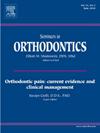Functional outcomes of maxillary expansion in anatomic phenotypes: Current evidence, clinical protocols and crossroads!
IF 2.2
4区 医学
Q2 DENTISTRY, ORAL SURGERY & MEDICINE
引用次数: 0
Abstract
Obstructive Sleep Apnea (OSA) in growing children and adolescents is a multifaceted condition marked by recurrent episodes of breathing interruptions during sleep due to upper airway collapsibility. The pathophysiology of pediatric OSA includes neuromotor dysfunction, inflammation, and anatomical factors related to soft tissues and craniofacial morphology. The prevalence of OSA in children varies between 1-10%, and its impact can extend to behavioral, neurocognitive, cardiovascular, and metabolic issues. Adolescence poses unique diagnostic challenges due to significant physical and hormonal changes, necessitating age-appropriate criteria for OSA assessment.
Maxillary transverse deficiency (MTD) is increasingly recognized as a critical craniofacial risk factor for pediatric OSA. Rapid Maxillary Expansion (RME) is an established intervention that opens the mid-palatal suture and enhances maxillary width, potentially alleviating symptoms associated with MTD. Micro implant-assisted RME is a promising alternative for severe cases or when conventional RME is insufficient, offering enhanced skeletal expansion. Further research is needed to validate the long-term functional benefits of these approaches in children and adolescents.
This paper showcases case reports that highlight the application of RME and micro implant-assisted RME in treating pediatric OSA patients, including a case with transverse maxillary constriction without adenotonsillar hyperplasia, and another case with unresolved breathing issues post-adenotonsillectomy. Orthodontic interventions in these patients resulted in significant reductions in the apnea-hypopnea index (AHI), alleviation of symptoms such as snoring and daytime sleepiness, and notable expansion of the nasal cavity. The value of case reports within the evidence pyramid should be acknowledged, highlighting the need for comprehensive clinical trials supported by evidence-based orthodontic practices before clinical best practices are established.
临时切除:上颌骨扩张对小儿和青少年阻塞性睡眠呼吸暂停颅面表型的影响
出版商很抱歉暂时删除了这篇文章。我们将尽快发布替代文章,其中将说明删除文章的原因,或者恢复文章。
本文章由计算机程序翻译,如有差异,请以英文原文为准。
求助全文
约1分钟内获得全文
求助全文
来源期刊

Seminars in Orthodontics
DENTISTRY, ORAL SURGERY & MEDICINE-
CiteScore
2.20
自引率
4.80%
发文量
28
审稿时长
10 days
期刊介绍:
Each issue provides up-to-date, state-of-the-art information on a single topic in orthodontics. Readers are kept abreast of the latest innovations, research findings, clinical applications and clinical methods. Collection of the issues will provide invaluable reference material for present and future review.
 求助内容:
求助内容: 应助结果提醒方式:
应助结果提醒方式:


